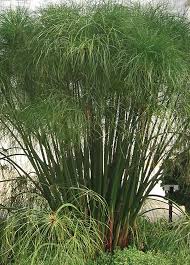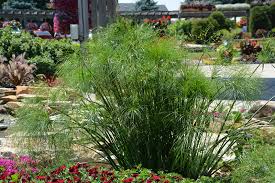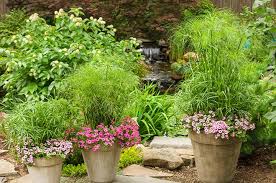King Tut Grass, scientifically known as Cyperus papyrus, is a fascinating plant that stands out for its unique appearance and historical significance. This water-loving plant has captured the attention of people around the world due to its distinctive features and the role it played in ancient civilizations.
King Tut Grass is a tall and graceful plant that typically grows in wetlands and along the banks of rivers and lakes. Its long, slender stems can reach impressive heights, sometimes towering over 10 feet. The stems are topped with umbrella-like clusters of feathery, thread-like leaves that create a distinct and elegant look. These leaves are often used in crafts and ornamental arrangements due to their striking appearance.
This plant holds a special place in history, particularly in ancient Egypt. The stems of King Tut Grass were used to make papyrus, an early form of paper that played a crucial role in recording and preserving knowledge during ancient times. The ancient Egyptians used papyrus to create scrolls, documents, and even religious texts. The availability of papyrus helped shape the development of their culture and communication methods.
Beyond its practical applications, King Tut Grass also found its way into the realm of art and culture. The plant’s unique appearance and historical significance have made it a popular choice for landscaping and ornamental gardens. Its elegant stems and feathery tufts can add a touch of exotic beauty to any outdoor space. Additionally, the plant’s presence in ancient Egyptian art and mythology has contributed to its enduring appeal.
Cultivating King Tut Grass requires an understanding of its preferred habitat. This plant thrives in moist or even aquatic environments, making it an excellent choice for water gardens or areas with consistently damp soil. When planting King Tut Grass, be sure to provide adequate space for its tall growth and consider placing it near a water source to mimic its natural habitat. Regular watering and occasional fertilization can help ensure healthy growth.
In the world of plants, King Tut Grass stands as a remarkable and historically significant species. Its scientific name, Cyperus papyrus, reflects its connection to ancient Egyptian culture and the valuable role it played in shaping the course of history. With its graceful appearance, cultural significance, and ability to thrive in water-rich environments, King Tut Grass continues to capture the imagination of people today, just as it did thousands of years ago.
Read Also: The Different Types of Housing for Fishes
Growing King Tut Grass

King Tut Grass, scientifically known as Cyperus papyrus, is an impressive plant that can add a touch of exotic beauty to your garden or landscape. With its tall stems and unique feathery leaves, it’s sure to capture the attention of anyone who sees it. If you’re interested in growing King Tut Grass, follow this simple guide to ensure successful cultivation.
1. Choosing the Right Location: King Tut Grass thrives in moist to wet environments, so selecting the right location is crucial. Look for a spot in your garden or landscape where the plant can receive full sun to partial shade. Additionally, consider placing it near a water source, such as a pond or a well-draining area that retains moisture.
2. Soil Preparation: Prepare the soil before planting. King Tut Grass prefers rich, loamy soil that retains moisture. Ensure good drainage to prevent waterlogged roots. You can amend the soil with organic matter, such as compost, to improve its water-holding capacity.
3. Planting: Plant King Tut Grass either directly in the ground or in containers. If planting in the ground, dig a hole that is slightly larger than the root ball. Gently place the plant in the hole and backfill with soil. If using containers, choose a pot with good drainage and fill it with a mixture of potting soil and compost.
4. Watering: Consistent watering is essential for King Tut Grass. Keep the soil consistently moist, especially during the growing season. Water the plant thoroughly whenever the top inch of soil feels dry to the touch. Avoid allowing the soil to become waterlogged, as this can lead to root rot.
5. Fertilization: Apply a balanced, slow-release fertilizer in the spring to provide nutrients for healthy growth. Follow the manufacturer’s instructions for application rates. Additionally, you can top-dress the soil with compost to enrich the soil throughout the growing season.
6. Pruning and Maintenance: King Tut Grass generally requires minimal pruning. However, you can remove any dead or damaged leaves to maintain its neat appearance. If the plant becomes overcrowded, thin out some of the stems to allow for better air circulation.
7. Winter Care: In regions with cold winters, King Tut Grass is often treated as an annual or tender perennial. Before the first frost, you can dig up potted plants and bring them indoors to overwinter. Alternatively, you can cut back the foliage and cover the plant with a thick layer of mulch to protect the roots from freezing temperatures.
8. Propagation: You can propagate King Tut Grass through division. Divide established plants every few years in the spring before new growth emerges. Gently separate the clumps into smaller sections, each with a portion of roots and stems, and replant them in suitable locations.
Growing King Tut Grass can be a rewarding experience, adding a touch of history and elegance to your outdoor space. By providing the right growing conditions, proper care, and maintenance, you can enjoy the striking beauty of this unique plant for seasons to come. Whether as a centerpiece in a water garden or an eye-catching addition to your landscape, King Tut Grass is sure to captivate and delight all who encounter it.
Caring for King Tut Grass

Caring for King Tut Grass, scientifically known as Cyperus papyrus, involves providing the right conditions to ensure its healthy growth and striking appearance. This guide will help you maintain this unique plant and enjoy its beauty year-round.
1. Watering: King Tut Grass thrives in moist to wet conditions. Keep the soil consistently moist, especially during the growing season. Water the plant deeply whenever the top inch of soil feels dry. Be careful not to let the soil become waterlogged, as this can lead to root rot.
2. Sunlight: Provide King Tut Grass with full sun to partial shade. It requires at least 6 hours of direct sunlight daily for optimal growth. If you’re growing it indoors, place it near a bright window where it can receive adequate sunlight.
3. Soil: Plant King Tut Grass in well-draining, rich soil. Amending the soil with compost or organic matter can help improve its water retention and nutrient content. The pH of the soil should ideally be slightly acidic to neutral.
4. Fertilization: Feed King Tut Grass with a balanced, slow release fertilizer in the spring, when new growth begins. Follow the manufacturer’s instructions for the appropriate dosage. Over-fertilization can lead to excessive growth and weak stems.
5. Pruning: While King Tut Grass generally requires minimal pruning, you can remove dead or damaged leaves to maintain its appearance. If the plant becomes too crowded, thin out some stems to allow for better air circulation and prevent disease.
6. Overwintering: In colder climates, King Tut Grass is often treated as an annual or tender perennial. Before the first frost, cut back the foliage to a few inches above the soil surface. Mulch heavily around the base of the plant to protect the roots from freezing temperatures. Alternatively, you can bring potted plants indoors to overwinter.
7. Pest and Disease Management:
King Tut Grass is relatively pest-resistant, but it can occasionally be affected by aphids or spider mites. Regularly inspect the plant for any signs of pests and address them promptly with appropriate treatments. Good air circulation and proper spacing can help prevent disease issues.
8. Container Care: If growing King Tut Grass in containers, choose a pot with drainage holes to prevent waterlogging. Ensure the pot is large enough to accommodate the plant’s growth. Water container-grown plants slightly more frequently, as they can dry out faster than those planted in the ground.
9. Propagation: You can propagate King Tut Grass through division. Divide established plants every few years in the spring. Gently separate the clumps into smaller sections, each with roots and stems, and replant them in suitable locations.
10. Aesthetic Use: Consider using King Tut Grass as a focal point in water gardens, along pond edges, or in containers placed near water features. Its tall stems and feathery leaves create a captivating and elegant visual effect.
By following these care guidelines, you can ensure the well-being of your King Tut Grass and enjoy its striking presence as it thrives and enhances your garden or landscape.
Read Also: How many plots of land do I need to start fish farming?
Importance of King Tut Grass

King Tut Grass, scientifically referred to as Cyperus papyrus, holds both historical and ecological importance, contributing to various aspects of human culture and the environment.
1. Historical Significance: One of the most significant aspects of King Tut Grass is its historical importance, particularly in ancient Egyptian culture. The plant’s stems were used to create papyrus, an early form of paper that played a pivotal role in recording and preserving knowledge in ancient times. The availability of papyrus facilitated the spread of information, contributing to the development of literature, art, and communication in ancient Egypt. The significance of papyrus extended beyond Egypt, as it influenced other cultures and societies through trade and exchange of ideas.
2. Cultural Symbolism: King Tut Grass is a symbol of the rich cultural heritage of ancient Egypt. Its presence in art, architecture, and religious practices reflects the esteem with which it was held. Depictions of King Tut Grass in hieroglyphics and artwork offer insights into the daily life and beliefs of ancient Egyptians. Today, the plant continues to be associated with the mystique and allure of ancient Egypt, often used in cultural displays and events.
3. Ecological Role: From an ecological perspective, King Tut Grass serves as an essential component of wetland ecosystems. Its ability to grow in water-rich environments makes it a valuable contributor to stabilizing soil, preventing erosion, and providing habitat for aquatic organisms. The plant’s dense root system helps improve water quality by absorbing excess nutrients and filtering water, thereby supporting the health of aquatic ecosystems.
4. Ornamental and Aesthetic Value: King Tut Grass has gained popularity as an ornamental plant due to its distinctive appearance. Its tall stems, crowned with feathery tufts of leaves, add a touch of elegance to gardens, landscapes, and water features. The visual impact of King Tut Grass makes it a sought-after choice for creating focal points in both outdoor and indoor settings.
5. Educational Purposes: Studying King Tut Grass and its historical significance can provide valuable insights into the interplay between plants and human civilizations. Learning about the role of papyrus in ancient communication methods offers a unique perspective on the evolution of writing and information dissemination.
Additionally, the plant’s ecological role in wetlands underscores the importance of preserving and restoring these vital ecosystems.
In summary, King Tut Grass holds a multifaceted importance that spans history, culture, ecology, and aesthetics. Its role in ancient Egyptian society, as well as its contributions to wetland ecosystems and ornamental landscapes, make it a plant that continues to captivate and inspire people to this day.
Whether as a reminder of the past, an ecological champion, or a visually stunning addition to gardens, King Tut Grass remains a plant of significance with a legacy that endures.
Read Also: Relationship Marketing Process and Approaches to the Study of Marketing
